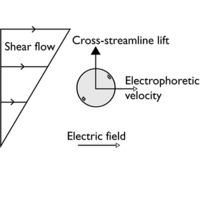当前位置:
X-MOL 学术
›
Phys. Rev. Fluids
›
论文详情
Our official English website, www.x-mol.net, welcomes your
feedback! (Note: you will need to create a separate account there.)
Migration of an electrophoretic particle in a weakly inertial or viscoelastic shear flow
Physical Review Fluids ( IF 2.5 ) Pub Date : 2020-03-16 , DOI: 10.1103/physrevfluids.5.033702 Aditya S. Khair , Jason K. Kabarowski
Physical Review Fluids ( IF 2.5 ) Pub Date : 2020-03-16 , DOI: 10.1103/physrevfluids.5.033702 Aditya S. Khair , Jason K. Kabarowski

|
The motion of a spherical particle undergoing electrophoresis in weakly inertial or viscoelastic shear flow is quantified via asymptotic analysis. We are motivated by several experimental studies reporting cross-streamline migration of electrophoretic colloids in Poiseuille microchannel flow. Specifically, particles migrate in a Newtonian liquid to the center (walls) of a channel when their electrophoretic velocity is in the opposite (same) direction to (as) the flow. Here, we calculate that weak fluid inertia causes a leading-order cross-streamline lift force of magnitude for electrophoresis along the velocity axis of an unbounded simple shear flow, where and denote the particle zeta potential and radius, respectively; , , and are the fluid density, viscosity, and permittivity, respectively; is the shear rate of the ambient flow; and is the strength of the imposed electric field. This force acts to propel the sphere to shear streamlines that, in a frame translating with the particle, are directed reverse to the electrophoretic motion, which is consistent with the above-mentioned experiments. Other recent experiments have observed migration of electrophoretic particles in Poiseuille flow of a viscoelastic polymer solution: the migration direction is opposite to that in a Newtonian liquid. Here, we calculate a leading-order cross-streamline lift force of magnitude for electrophoresis in simple shear flow of a second-order fluid, where and are the first and second normal stress coefficients, respectively. The lift is toward streamlines moving in the direction of electrophoresis for (a reasonable assumption for polymeric liquids, where and are negative and positive, respectively), which is consistent with the experiments. Finally, an estimation of the magnitude of the lift forces and associated drift velocities further suggests that the cumulative effect of weak instantaneous inertia or viscoelasticity is responsible, or at least contributes appreciably, to the observed migration.
中文翻译:

电泳颗粒在弱惯性或粘弹性剪切流中的迁移
通过渐近分析对在弱惯性或粘弹性剪切流中进行电泳的球形颗粒的运动进行定量。我们受到一些实验研究的启发,这些研究报告了电泳胶体在Poiseuille微通道流中的跨流线迁移。具体而言,当粒子的电泳速度与流动方向相反(相同)时,粒子在牛顿液体中迁移至通道的中心(壁)。在这里,我们计算出弱的流体惯性会导致数量级为前导的跨流线提升力 沿无限制简单剪切流的速度轴进行电泳,其中 和 分别表示粒子的ζ电势和半径; , 和 分别是流体密度,粘度和介电常数; 是环境流量的剪切率;和是施加的电场强度。该力促使球体剪切流线,该流线在与粒子平移的框架中指向与电泳运动相反的方向,这与上述实验一致。最近的其他实验还观察到电泳粒子在粘弹性聚合物溶液的泊瓦(Poiseuille)流中迁移:迁移方向与牛顿液体中的迁移方向相反。在这里,我们计算了一个领先的跨流线提升力的大小 用于在二阶流体的简单剪切流中进行电泳,其中 和 分别是第一和第二法向应力系数。升降机朝着沿电泳方向移动的流线移动 (对于聚合物液体的合理假设,其中 和 分别为负和正),这与实验一致。最后,对提升力的大小和相关的漂移速度的估计还表明,瞬时惯性或粘弹性较弱的累积效应对观察到的迁移负责,或至少有明显贡献。
更新日期:2020-03-16
中文翻译:

电泳颗粒在弱惯性或粘弹性剪切流中的迁移
通过渐近分析对在弱惯性或粘弹性剪切流中进行电泳的球形颗粒的运动进行定量。我们受到一些实验研究的启发,这些研究报告了电泳胶体在Poiseuille微通道流中的跨流线迁移。具体而言,当粒子的电泳速度与流动方向相反(相同)时,粒子在牛顿液体中迁移至通道的中心(壁)。在这里,我们计算出弱的流体惯性会导致数量级为前导的跨流线提升力 沿无限制简单剪切流的速度轴进行电泳,其中 和 分别表示粒子的ζ电势和半径; , 和 分别是流体密度,粘度和介电常数; 是环境流量的剪切率;和是施加的电场强度。该力促使球体剪切流线,该流线在与粒子平移的框架中指向与电泳运动相反的方向,这与上述实验一致。最近的其他实验还观察到电泳粒子在粘弹性聚合物溶液的泊瓦(Poiseuille)流中迁移:迁移方向与牛顿液体中的迁移方向相反。在这里,我们计算了一个领先的跨流线提升力的大小 用于在二阶流体的简单剪切流中进行电泳,其中 和 分别是第一和第二法向应力系数。升降机朝着沿电泳方向移动的流线移动 (对于聚合物液体的合理假设,其中 和 分别为负和正),这与实验一致。最后,对提升力的大小和相关的漂移速度的估计还表明,瞬时惯性或粘弹性较弱的累积效应对观察到的迁移负责,或至少有明显贡献。











































 京公网安备 11010802027423号
京公网安备 11010802027423号